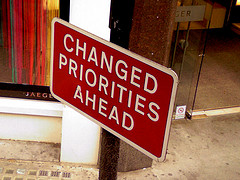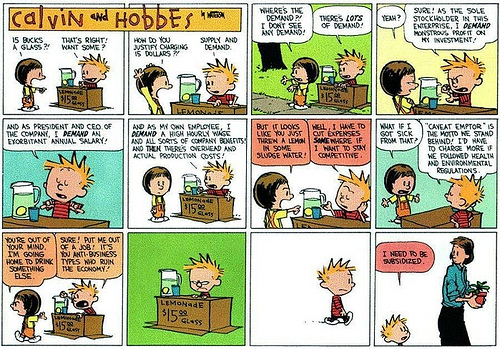|
|
|
Archive for May, 2009
Saturday, May 16th, 2009
CEOs have the spotlight today—about them, from them and for them.
 CEOs have never liked anything that comes between them and the compensation they believe they deserve—not independent directors, governance gurus, sensibility and certainly not TARP. Business Week offers an interesting overview of TARP’s effect on CEO engagement, but it’s the readers’ comments that make the story unique. CEOs have never liked anything that comes between them and the compensation they believe they deserve—not independent directors, governance gurus, sensibility and certainly not TARP. Business Week offers an interesting overview of TARP’s effect on CEO engagement, but it’s the readers’ comments that make the story unique.
What exactly does a CEO contribute to the organization? In an excellent article from A.G. Lafley, Procter & Gamble’s CEO, talks about the most important things to focus on, wherever you are in the business cycle.
Now learn interesting lessons from a Bollywood dance class and a parent who asks “Can our leaders dance?”.
By now, everybody has heard of Susan Boyle; in this article from Harvard Business Publishing Peter Bregman discusses how to find the ‘Susan Boyles’, i.e., hidden talent, in your organization.
Your comments—priceless
Don’t miss a post, subscribe via RSS or EMAIL
Image credit: nono farahshila on flickr
Posted in About Leadership, management, What Leaders DO | No Comments »
Friday, May 15th, 2009
Yesterday I talked about the importance of failing fast, learning and moving on. I received an email from Chris asking what the best way to move past failure was. He said he was penalized for any goal missed or effort that fell short all his growing years and couldn’t seem to get over it as an adult.
Chris is not alone; like Pavlov’s dog we humans also respond to conditioning and as with every living organism people avoid doing things that they’ve been conditioned to believe brings humiliation—or worse.
As I said, Chris’ difficulty isn’t unusual and there are many ways to approach it. I know one coach who routinely recommends therapy, but I’m a bit more pragmatic than that. While therapy may help in the long run, most people want tools they can use to move forward now.
To do that, start with your definition of failure.
It’s believing that so-called failure actually means something that creates the fear of it. But I’m willing to bet that the times you ‘failed’ you weren’t struck by a thunderbolt, the earth didn’t stop turning and the sun still rose in the east.
In other words, what you tried didn’t work, so try something else.
 Failing does not equate to death; as long as you get up, falling on your butt shouldn’t be a big deal. Failing does not equate to death; as long as you get up, falling on your butt shouldn’t be a big deal.
You can even get up slowly; take time to let the ibuprofen work before you form another plan and try again. Falling down isn’t the problem, it’s not getting up that’s the problem.
Of course, knowing this and implementing it are two different things. Chris is going to think over what we discussed and call aback; I told him that if it makes sense to him I’d be happy to coach him through it.
I’ll keep you posted.
Image credit: Hugo |-| on flickr
Posted in Business info, Motivation, Personal Growth | No Comments »
Friday, May 15th, 2009
For all the talk about bullying, one dirty little secret is just starting to see the light of day.
Bullies are split 60/40 (men/women), but while men are equal opportunity bullies—they stomp on anyone— women are more likely to bully other women “more than 70 percent of the time.”
That doesn’t surprise me, all my life I’ve always gotten more mentoring and support from men than I have from women.
I’ve seen too many women crushed because whatever was done to them was done by another woman, so there was a major betrayal factor added to whatever else was involved.
 I never bought into the whole sisterhood thing. It just never made any sense to me to that 50% of the population could be trusted because we all had the same plumbing and the other 50% were enemies because theirs was different. I never bought into the whole sisterhood thing. It just never made any sense to me to that 50% of the population could be trusted because we all had the same plumbing and the other 50% were enemies because theirs was different.
No more sense than assuming that other external differences, such as race, religion or sexual orientation, guarantee a trustworthy ally.
Bullies pick on those they see as weaker and less likely to fight back, so while I was never bullied I was targeted for more sabotage because I was perceived as a threat—or maybe sabotage qualifies as bullying.
Thinking back, most of the people termed bullies and chauvinists were weak, petty and insecure, so I pretty much ignored them.
I’ve always tended to look beyond surface appearance, probably in the hope that my attitude would be reciprocated.
For me it’s minds and MAP (mindset, attitude, philosophy™) that have value—what does it for you?
Your comments—priceless
Don’t miss a post, subscribe via RSS or EMAIL
Image credit: nygma on sxc.hu
Posted in Conflict, Group Dynamics, Personal Development | 2 Comments »
Thursday, May 14th, 2009
I was looking at some old notes and found something I’d saved from the comments area of a post on changing corporate culture at Dell’s IdeaStorm, “After all, if you don’t challenge yourselves, do you expect to grow? You certainly won’t LEAD.”
 I don’t know if it’s original, but it is short, sweet and very true. I don’t know if it’s original, but it is short, sweet and very true.
If there’s one thing that challenging yourself does it’s to upset the status quo—that’s what forces growth.
That’s true for your company, department, team—and yourself.
Challenges usually involve risk, but risk is healthy.
Risk can be safe if you
- evaluate it;
- perform worst case analysis; and
- go for it.
Risk often, fail fast, learn and move on.
You’ll blow away the competition.
Image credit: flattop341 on flickr
Posted in Business info, Culture, Personal Growth | No Comments »
Thursday, May 14th, 2009
I’ve written a lot about the problems and difficulties with Gen Y, but I want to make something clear.
Gen Y didn’t raise themselves to feel entitled, require constant praise or expect success for trying their hardest.
Jan left a comment a few weeks ago and I think she speaks for a large number of her generation, “There is a great amount of pressure to earn good grades and gain a GREAT career, as if somehow that is the only way to gain success in our lives. … The present often does not matter, including learning the subject. Students live under this constant pressure to make good grades, with that fear of failure programmed into the back of our minds.” (Please take a moment to read her entire comment.)
Decades ago after my sister had her first child she said, “I know that I’ll do things that mess up my kids, but they damn well won’t be the same things that messed us up,” and they weren’t.
 This is normal life, with the previous generation screwing up their kids in some way and the kids eventually sorting it out—or not—and then moving on to the next generation, but it’s changed now. This is normal life, with the previous generation screwing up their kids in some way and the kids eventually sorting it out—or not—and then moving on to the next generation, but it’s changed now.
Greg Jayne is the Sports Editor for my local paper and he summed it up nicely in a column about the people’s attitude towards performance enhancing drugs.
“Last year, Major League Baseball drew 78.6 million spectators to the ballpark… The sport generated about $6 billion in revenue, nearly twice what it generated in 2000 and roughly $20 for every man, woman and child in the United States. … The baseball-watching public simply doesn’t care that much about players who cheat the game. … We live in an era in which style trumps substance, and the superficial is held in such high regard that we all are diminished. Is there any reason to think that baseball should be different? Is there any reason to express moral outrage when somebody is trying to improve his performance and help his team win? That is, after all, the ethos of the time.”
Yet there are still supposed to be areas that are sacrosanct, people we assume will work for the good of our kids; people to whom we don’t give a second thought—until their actions blow up in our faces.
Priests/ministers/rabbis. Teachers. Family. Judges.
It’s terrible when people are driven by their own inner demons, but somehow it’s even worse when they ruin kids’ lives out of plain old fashioned greed.
“…two judges pleaded guilty to tax evasion and wire fraud in a scheme that involved sending thousands of juveniles to two private detention centers in exchange for $2.6 million in kickbacks. … Virtually all former colleagues and courthouse workers would not allow themselves to be identified because the federal investigation into the kickback scheme was continuing and they feared for their jobs if they alienated former allies of the judges.”
Obviously, it’s not just individuals, but the laissez faire attitude prevalent in a large percentage of all generations that’s driving the problems to levels not seen previously.
Enough is enough. We need change—but where to start?
Your comments—priceless
Don’t miss a post, subscribe via RSS or EMAIL
Image credit: drinksmachine on flickr
Posted in Ethics, Leadership's Future, What Do You Think? | 1 Comment »
Wednesday, May 13th, 2009
Note: this Calvin dates back about 15 years. (<sigh> I still miss Calvin!)

Be sure to check out yet another bad culture
Image credit: feloniousrambler on flickr
Posted in Business info, Just For Fun, Wordless Wednesday | No Comments »
Wednesday, May 13th, 2009

See how Calvin explains the economy
Your comments—priceless
Don’t miss a post, subscribe via RSS or EMAIL
Image credit: Combined Media on flickr
Posted in management, What Leaders DON'T, Wordless Wednesday | 1 Comment »
Tuesday, May 12th, 2009
Last week I described way to use an innovation wiki to juice creativity and garner ideas from all parts of the company. In the comments Jennifer Brown said, “…[is a] platform across the entire enterprise wherein the innovation “conversation” occurs – not just team by team/vertical by vertical, but across verticals that typically don’t talk to each other (hence leading to silos) or collaborate. …harness the power of the workforce, break the silo’d thinking of functional structures, and revolutionize business models.”
 I agree, but done with a small innovative twist an innovation wiki will break down not only departmental silos, but also the insidious horizontal silos that are based on position and education. I agree, but done with a small innovative twist an innovation wiki will break down not only departmental silos, but also the insidious horizontal silos that are based on position and education.
Personally, I loathe horizontal silos and consider them second only to politics on the corporate stupidity index.
More times than I can count I’ve seen the ideas of an engineer 1 or 2 discounted or ignored by the 3s and senior engineers—of course, that’s better than stealing them, although that happens, too.
The attitude seems to be one of ‘your brain is incapable of any creative thinking until you are at least at my pay grade’, which is idiotic.
People’s brains work differently; some see what is, others see possible improvements and a few see around corners, but that sight has little to do with position. Steve Jobs saw around the corner of the personal computer market before there was a personal computer market and certainly before he had any credibility what so ever.
Nor is it always about training and education. 20 odd years ago I redesigned two street intersection where I lived in San Francisco, but I didn’t suggest the solutions to the traffic engineers—I knew they wouldn’t listen because I have no training. Instead, I sneaked both ideas in through someone I know who was ‘accepted’ and both are still in effect today.
Silos are built of egos, which is why, vertical or horizontal, they’re so difficult to break down.
The best solution is for the CEO to build a culture that values everybody’s ideas equally, but technology offers a leg up on this.
When building your innovation wiki assign a random ID to each suggestion—sort of like match.com. They must be completely random so that level, grade and even department are totally obscured. Each idea has a different ID, so that when a person’s idea is used the next one is still anonymous; limit access of the actual name to a few top executives.
That anonymity truly levels the playing field and means that each idea is considered strictly on its merits, not on the merits of the person who thought of it. It also encourages people to way outside-the-box thinking and to post ideas without worrying about appearing silly, pushy or arrogant for offering ideas outside of their personal expertise.
Just be sure that the contributors of ideas that are used, whether all, in part or as a springboard to something else, receive plenty of public acknowledgement, kudos and anything else you’re in a position to do.
Your comments—priceless
Don’t miss a post, subscribe via RSS or EMAIL
Image credit: ZedBee|Zoë Power on flickr
Posted in Conflict, Ducks In A Row, Innovation | 6 Comments »
Tuesday, May 12th, 2009
In previous posts I shared my views regarding the shape of the recovery and shape of employment in the future.
The President and Congress have told us, this recovery will also cost a few trillion, so the open question is: how the value of the dollar will change in the months and years ahead? Deflation, inflation, or both?
 The following is what I think may happen. The following is what I think may happen.
First, the Fed Rebuilds the Banks
According to the Fed, total mortgage debt exceeded $14 Trillion as of Dec. 31, 2007.The best estimate is that 10-20% of that debt must be written off due to the drop in house values. That’s $1.4-$2.8 Trillion. Assuming US banks hold only 50% of that debt, that’s $700 Billion to $1.4 Trillion that needs to be removed from their balance sheets for mortgage debt alone. That does not include credit card debt, auto loan debt, student loans, or business debt. The Fed will have to print enough funds to cover the debt, lending to the chosen banks. Those funds will not provide any stimulus, as the dollars will simply re-establish the reserve levels that banks are legally required to carry.
Second, Consumers Start Saving—Near Term Deflation
Of the US $14 Trillion GDP, 70% ($10 Trillion) is driven by consumer spending. If consumers increase their savings rate from -2% to +5%, another $700 Billion (7% of $10 Trillion) will be removed from the economy, creating an additional 5% drop in the GDP. In the short term we will have deflation, driven by declining demand. Sure enough, that’s just what has happened in the past four quarters.
Third, the World Redeems Dollars—Long Term Inflation
With over $7 Trillion dollars flowing internationally as global reserves outside the US ($2 in China, $2 in Japan, $2 in OPEC, and $1 in Europe), plus the $7 Trillion the Fed has already printed in the past year, over $14 Trillion (1x GDP) in cash is beyond the control of the US.
Sometime in 2010-2011, the US may see currency deflation as other countries spend their dollar reserves to dig out of their own recessions. Remember that we produce very little of our own hard goods, They come from China, Japan, Korea and other countries. We buy energy from OPEC. If the dollar drops vis-à-vis Korea, Japan, China, and OPEC, then the US may see an increase in the price of hard goods and energy.
Granted, any price rise will be moderated by the domestic drop in consumption, but the US no longer controls the price of global goods, services, and energy. The US share of global commerce is 23%, and declining. Global consumption will increase, regardless of the US. Prices will rise, and the dollar will likely decline against other currencies—a one-two punch for the US.
What Do You Think?
What is your forecast for GDP and deflation/inflation? How does it affect your business planning?

Posted in Business info, Strategy | No Comments »
Monday, May 11th, 2009
I live in the great Pacific Northwest—the great, wet Pacific Northwest.
Our spring is late and what we’ve had has dribbled in a couple of days here and a couple there. Starting Friday we finally had three whole days of spring and I had a yard that needed major help.
The result of 30+ hours of hard labor is a vast improvement in the yard and I am totally whacked. So I chose a post from last year; I hope you enjoy it.
Corporate Culture I/O
 Corporate culture has begotten a thriving industry that researches, dissects, writes, discusses, preaches, teaches, and studies it—all with the goal of helping people understand its effects and learn how to improve it. Corporate culture has begotten a thriving industry that researches, dissects, writes, discusses, preaches, teaches, and studies it—all with the goal of helping people understand its effects and learn how to improve it.
It’s considered a soft science, a moving target, amorphous and difficult to pin down.
But I’ve always believed that corporate culture has much in common with a computer.
Yes, a computer, with its unyielding hardware and logical, literal software.
You see, in computing, the term I/O refers to input, whatever is received by the system, and output, that which results from the processing.
Programmers know that if you enter incorrect or bad data the results coming out of the computer won’t have much value, hence the term “garbage in/garbage out.”
And there you have it—the similarity between computers, corporate culture and most everything else in life.
What comes out is a function of what you put in.
Blindly accepting everything offered—whether from the guru du jour or religious texts—is sure to result in garbage out at some point.
Improving corporate culture requires critical thinking on your part. No one person, past, present or future, has all the answers. You need to evaluate the available information, take a bit from here and a bit from there, apply it to your situation and, like a computer, process it.
The resulting culture will differ from what you start with, because you’ve added the flavor of your own life experiences, knowledge and MAP to the mix and that’s good—different people, different culture.
A viable corporate culture is a living organism, growing and changing all the time and you’re contributing to that growth.
Do you contribute to your company’s culture?
Image credit: vivekchugh on sxc.hu
Posted in Business info, Culture, Retention | No Comments »
|
 Subscribe to
Subscribe to
MAPping Company Success
About Miki 
Clarify your exec summary, website, etc.
Have a quick question or just want to chat? Feel free to write or call me at 360.335.8054
The 12 Ingredients of a Fillable Req
CheatSheet for InterviewERS
CheatSheet for InterviewEEs™
Give your mind a rest. Here are 4 quick ways to get rid of kinks, break a logjam or juice your creativity!
Creative mousing
Bubblewrap!
Animal innovation
Brain teaser
The latest disaster is here at home; donate to the East Coast recovery efforts now!
Text REDCROSS to 90999 to make a $10 donation or call 00.733.2767. $10 really really does make a difference and you'll never miss it.
And always donate what you can whenever you can
The following accept cash and in-kind donations: Doctors Without Borders, UNICEF, Red Cross, World Food Program, Save the Children
*/
?>About Miki
About KG
Clarify your exec summary, website, marketing collateral, etc.
Have a question or just want to chat @ no cost? Feel free to write
Download useful assistance now.
Entrepreneurs face difficulties that are hard for most people to imagine, let alone understand. You can find anonymous help and connections that do understand at 7 cups of tea.
Crises never end.
$10 really does make a difference and you’ll never miss it,
while $10 a month has exponential power.
Always donate what you can whenever you can.
The following accept cash and in-kind donations:
|
 CEOs have never liked anything that comes between them and the compensation they believe they deserve—not independent directors, governance gurus, sensibility and certainly not TARP. Business Week offers an interesting overview of TARP’s effect on CEO engagement, but it’s the readers’ comments that make the story unique.
CEOs have never liked anything that comes between them and the compensation they believe they deserve—not independent directors, governance gurus, sensibility and certainly not TARP. Business Week offers an interesting overview of TARP’s effect on CEO engagement, but it’s the readers’ comments that make the story unique.



 Failing does not equate to death; as long as you get up, falling on your butt shouldn’t be a big deal.
Failing does not equate to death; as long as you get up, falling on your butt shouldn’t be a big deal. I never bought into the whole sisterhood thing. It just never made any sense to me to that 50% of the population could be trusted because we all had the same plumbing and the other 50% were enemies because theirs was different.
I never bought into the whole sisterhood thing. It just never made any sense to me to that 50% of the population could be trusted because we all had the same plumbing and the other 50% were enemies because theirs was different. I don’t know if it’s original, but it is short, sweet and very true.
I don’t know if it’s original, but it is short, sweet and very true. This is normal life, with the previous generation screwing up their kids in some way and the kids eventually sorting it out—or not—and then moving on to the next generation, but it’s changed now.
This is normal life, with the previous generation screwing up their kids in some way and the kids eventually sorting it out—or not—and then moving on to the next generation, but it’s changed now.

 I agree, but done with a small innovative twist an innovation wiki will break down not only departmental silos, but also the insidious horizontal silos that are based on position and education.
I agree, but done with a small innovative twist an innovation wiki will break down not only departmental silos, but also the insidious horizontal silos that are based on position and education. The following is what I think may happen.
The following is what I think may happen.
 Corporate culture has begotten a thriving industry that researches, dissects, writes, discusses, preaches, teaches, and studies it—all with the goal of helping people understand its effects and learn how to improve it.
Corporate culture has begotten a thriving industry that researches, dissects, writes, discusses, preaches, teaches, and studies it—all with the goal of helping people understand its effects and learn how to improve it.
